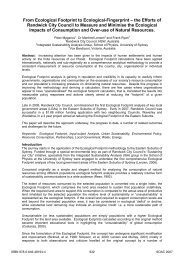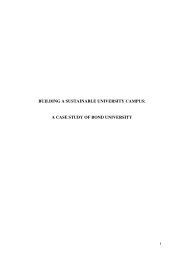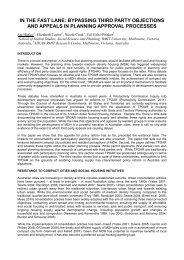How dense are we? Another look at urban density and transport ...
How dense are we? Another look at urban density and transport ...
How dense are we? Another look at urban density and transport ...
- No tags were found...
Create successful ePaper yourself
Turn your PDF publications into a flip-book with our unique Google optimized e-Paper software.
<strong>How</strong> <strong>dense</strong> <strong>are</strong> <strong>we</strong>?This is not to argue th<strong>at</strong> unplanned <strong>urban</strong> sprawl should continue to devour farms <strong>and</strong> forests.Most participants in the compact city deb<strong>at</strong>e <strong>are</strong> opposed to sprawl in the original sense of‘ribbon’ development along roads or ‘leapfrogging’ of housing est<strong>at</strong>es, producing anenvironment th<strong>at</strong> is ‘neither town nor country’. Vigorous critics of the compact city, such asHugh Stretton <strong>and</strong> P<strong>at</strong>rick Troy, <strong>are</strong> equally critical of unregul<strong>at</strong>ed fringe development.Similarly, <strong>urban</strong>ists on both sides of the deb<strong>at</strong>e support clustering sub<strong>urban</strong> activities intosub-centres instead of allowing them to spread r<strong>and</strong>omly across the l<strong>and</strong>scape. And sincethere is a dem<strong>and</strong> for higher-<strong>density</strong> housing, it makes sense to loc<strong>at</strong>e it in these centres, or inother places <strong>we</strong>ll-served by public <strong>transport</strong>. Measures of this kind have a range ofenvironmental advantages, including making it easier to provide effective public <strong>transport</strong>.The good news is th<strong>at</strong> <strong>we</strong> don’t need impossible increases in <strong>density</strong> to provide viablealtern<strong>at</strong>ives to the car. The rel<strong>at</strong>ive <strong>at</strong>tractiveness of competing <strong>urban</strong> <strong>transport</strong> modes seemsto influence mode choice much more than differences in <strong>density</strong>, <strong>and</strong> the notion th<strong>at</strong> 400 oreven 30 residents per hect<strong>are</strong> is a minimum <strong>density</strong> below which public <strong>transport</strong> cannot beprovided is unsupported by evidence. It even <strong>look</strong>s as if gre<strong>at</strong>er usage of public <strong>transport</strong>might go h<strong>and</strong>-in-h<strong>and</strong> with higher levels of walking, which would be excellent news for theenvironment.The necessary changes to <strong>transport</strong> policy <strong>are</strong> beyond the scope of this paper, but <strong>are</strong>discussed in Mees (2009). Transport policy can be changed more quickly <strong>and</strong> cheaply, <strong>and</strong>with less disruption, than city <strong>density</strong>, so it might even be possible to make the necessarychanges in time to save the planet.ReferencesABS (Australian Bureau of St<strong>at</strong>istics) (2006). St<strong>at</strong>istical Geography: Volume 1. (C<strong>at</strong>. 1216.0).Canberra.Banister, D. (2005). Unsustainable Transport: City <strong>transport</strong> in the new century. London:Routledge.Birrell, B., O’Connor, K., Rapson, V. & Healy, E. (2005). Melbourne 2030: Planningrhetoric verses <strong>urban</strong> reality. Clayton: Monash University ePress.Blakston, A. (2009). ‘A hothouse of clim<strong>at</strong>e ideas.’ The Age, 6 June, p. 23.Boulton, M. (2005). ‘Melbourne risks LA-style sprawl: Bracks.’ The Age, 23 March, p. 5.Bruegmann, R. (2005). Sprawl: a compact history. Chicago: University of Chicago Press.Dodson. J. & Sipe, N. (2008). Shocking the Suburbs: Oil vulnerability in the Australian city.Sydney: UNSW Press.EEA (European Environmental Agency) (2006). Urban sprawl in Europe: The ignoredchallenge (EEA Report No. 10/2006). Copenhagen: EEA.Garnaut, R. (2008). The Garnaut Clim<strong>at</strong>e Change Review. Melbourne: Cambridge UniversityPress.






